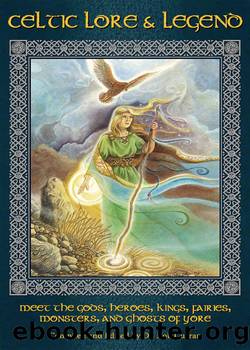Celtic Lore & Legend by Dr. Bob Curran

Author:Dr. Bob Curran
Language: eng
Format: epub
ISBN: 9781601635662
Publisher: Red Wheel Weiser
Amongst the Celts, the idea of prognosticationâthe foretelling of the futureâwas highly important. Warriors wished to know whether or not they would return from battle; young men and young women wanted to know whom they would marry; others simply wished to know what the future might hold in store for them. The gift of foretelling the future resided with the druids (the pagan Celtic priests) who could determine what lay in store by the movements of birds or clouds, from the way in which certain engraved sticks might fall after being thrown in the air, from the entrails of certain animals. There were those too who were deemed to possess a certain powerâto actually âseeâ the future. This was said to have been given as a gift either from the gods themselves or from other supernatural beings such as the Good Folk (fairies). The tradition of âseeingâ another future world or deriving interpretations from visions that no one else could see continued long after the druids were gone. In certain communities, there were individuals who were deemed to have the gift of what became known as âthe second sightâ (the ability to âseeâ things that were either to come or that lay beyond the sight of ordinary mortals). Many people who possessed this ability actually considered it to be a curse, as the visions were often involuntary and liable to come upon them without warning. In many instances they were the harbingers of doom, placing a dreadful knowledge and responsibility upon the seer.
Nowhere was this ability more prevalent than in the Highlands and Western Islands of Scotland. The Highland Seers men and women with the gift of the âsecond sightââwere famous the length and breadth of the Celtic world. These ranged from the celebrated Brahan Seer (Kenneth MacKenzie) of Ross-shire to the local âspae-wivesâ of the Hebrides. The Irish referred to the âgiftâ as the taish and declared it to be infallible. They paid homage to their Scottish cousins in whom âthe greatest giftâ resided.
The following account concerning the second sight is taken from Martin Martin's almost indispensable book A Description of the Western Isles of Scotland (first published about 1695).
Excerpt From A Description of the
Western Isles of Scotland
by Martin Martin
The second-sight is a singular faculty of seeing an otherwise invisible object, without any previous means used by the person who sees it for that end: the vision makes a lively impression upon the seers that they neither see nor think of anything else except the vision as long as it continuesâand then they appear pensive or jovial, according to the object which was represented to them.
At the sight of a vision, the eye-lids of the person are erected; the eyes continue staring until the object vanishes. This is obvious to others who are by, when the person happens to see a vision, and occurred more than once to my own observation, and to others that were with me.
There is one in Skye, of whom his acquaintance observed, that when
Download
This site does not store any files on its server. We only index and link to content provided by other sites. Please contact the content providers to delete copyright contents if any and email us, we'll remove relevant links or contents immediately.
Becoming Supernatural by Dr. Joe Dispenza(8127)
Crystal Healing for Women by Mariah K. Lyons(7857)
The Witchcraft of Salem Village by Shirley Jackson(7197)
Inner Engineering: A Yogi's Guide to Joy by Sadhguru(6730)
The Four Agreements by Don Miguel Ruiz(6643)
The Power of Now: A Guide to Spiritual Enlightenment by Eckhart Tolle(5613)
Secrets of Antigravity Propulsion: Tesla, UFOs, and Classified Aerospace Technology by Ph.D. Paul A. Laviolette(5313)
The Wisdom of Sundays by Oprah Winfrey(5089)
Room 212 by Kate Stewart(5041)
Pale Blue Dot by Carl Sagan(4920)
Fear by Osho(4663)
The David Icke Guide to the Global Conspiracy (and how to end it) by David Icke(4629)
Animal Frequency by Melissa Alvarez(4400)
Rising Strong by Brene Brown(4382)
How to Change Your Mind by Michael Pollan(4295)
Sigil Witchery by Laura Tempest Zakroff(4183)
Real Magic by Dean Radin PhD(4079)
Man and His Symbols by Carl Gustav Jung(4070)
The Art of Happiness by The Dalai Lama(4065)
